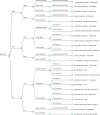The impact of improved detection and treatment of isoniazid resistant tuberculosis on prevalence of multi-drug resistant tuberculosis: A modelling study
- PMID: 30677101
- PMCID: PMC6345486
- DOI: 10.1371/journal.pone.0211355
The impact of improved detection and treatment of isoniazid resistant tuberculosis on prevalence of multi-drug resistant tuberculosis: A modelling study
Abstract
Introduction: Isoniazid-resistant, rifampin susceptible tuberculosis (INHR-TB) is the most common form of drug resistant TB globally. Treatment of INHR-TB with standard first-line therapy is associated with high rates of multidrug resistant TB (MDR-TB). We modelled the potential impact of INHR-TB detection and appropriate treatment on MDR-TB prevalence.
Methods: A decision analysis model was developed to compare three different strategies for the detection of TB (AFB smear, Xpert MTB/RIF, and Line-Probe Assays (LPA)), combined with appropriate treatment. The population evaluated were patients with a globally representative prevalence of newly diagnosed, drug-susceptible (88.6%), isoniazid-resistant (7.3%), and multidrug resistant (4.1%) pulmonary TB. Our primary outcome was the proportion of patients with MDR-TB after initial attempt at diagnosis and treatment within a 2-year period. Secondary outcomes were the proportion of i) individuals with detected TB who acquired MDR-TB ii) individuals who died after initial attempt at diagnosis and treatment.
Results: After initial attempt at diagnosis and treatment, LPA combined with appropriate INHR-TB therapy resulted in a lower proportion of prevalent MDR-TB (1.61%; 95% Uncertainty Range (UR: 2.5th and 97.5th percentiles generated from 10 000 Monte Carlo simulation trials) 1.61-1.65), when compared to Xpert (1.84%; 95% UR 1.82-1.85) and AFB smear (3.21%; 95% UR 3.19-3.26). LPA also resulted in fewer cases of acquired MDR-TB in those with detected TB (0.35%; 95% UR 0.34-0.35), when compared to Xpert (0.67%; 95% UR 0.65-0.67) and AFB smear (0.68%; 95% UR 0.67-0.69). The majority of acquired MDR-TB arose from the treatment of INHR-TB in all strategies. Xpert-based strategies resulted in a lower proportion of death (2.89%; 95% UR 2.87-2.90) compared to LPA (2.93%; 95% UR 2.91-2.94) and AFB smear (3.21%; 95% UR 3.19-3.23).
Conclusion: Accurate diagnosis and tailored treatment of INHR-TB with LPA led to an almost 50% relative decrease in acquired MDR-TB when compared with an Xpert MTB/RIF strategy. Continued reliance on diagnostic and treatment protocols that ignore INHR-TB will likely result in further generation of MDR-TB.
Conflict of interest statement
The authors have declared that no competing interests exist.
Figures




References
-
- World Health Organization. Global tuberculosis report 2017. In: WHO [Internet]. [cited 7 Dec 2017]. Available: http://www.who.int/tb/publications/global_report/en/
-
- Dheda K, Gumbo T, Maartens G, Dooley KE, McNerney R, Murray M, et al. The epidemiology, pathogenesis, transmission, diagnosis, and management of multidrug-resistant, extensively drug-resistant, and incurable tuberculosis. Lancet Respir Med. 2017;5: 291–360. - PubMed
MeSH terms
Substances
LinkOut - more resources
Full Text Sources
Medical
Miscellaneous

